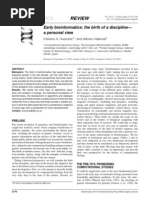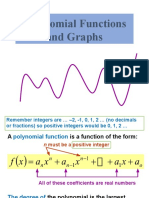0 ratings0% found this document useful (0 votes)
196 viewsLesson 3 - Functions Operations
The document discusses operations on functions such as addition, subtraction, multiplication, division, and composition of functions. It provides examples of determining the domain and formula of functions resulting from these operations. For addition, subtraction, and multiplication, the domain is the intersection of the domains of the original functions. For division and composition, the domain depends on whether the range of the inner function is contained within the domain of the outer function. The document also discusses expressing functions as compositions and finding the formula and domain of composite functions.
Uploaded by
Karen Dela TorreCopyright
© © All Rights Reserved
Available Formats
Download as PPT, PDF, TXT or read online on Scribd
0 ratings0% found this document useful (0 votes)
196 viewsLesson 3 - Functions Operations
The document discusses operations on functions such as addition, subtraction, multiplication, division, and composition of functions. It provides examples of determining the domain and formula of functions resulting from these operations. For addition, subtraction, and multiplication, the domain is the intersection of the domains of the original functions. For division and composition, the domain depends on whether the range of the inner function is contained within the domain of the outer function. The document also discusses expressing functions as compositions and finding the formula and domain of composite functions.
Uploaded by
Karen Dela TorreCopyright
© © All Rights Reserved
Available Formats
Download as PPT, PDF, TXT or read online on Scribd
You are on page 1/ 9
FUNCTIONS
OPERATIONS ON
FUNCTIONS
OBJECTIVES:
perform operations on functions;
determine the domain of the given
functions;
determine the domain of the resulting
functions
after performing the operations on
functions; and
define a composite function and give its
domain.
OPERATIONS ON FUNTIONS AND DETERMINATION
OF DOMAIN OF FUNCTIONS AS A RESULT OF
OPERATION
Definition 0.2.1 (p.
16)
EXAMPLE 1: (example 1 on p.16)
Let f ( x) 1 x 2 and g ( x) x 3
f
Find the domains and formulas for the functions f g , f g , fg , , and 7 f
g
Solution:
The formulas are :
f g ( x) f ( x) g ( x) 1 x 2 x 3 x 2 x2
fg ( x) f ( x) g ( x) 1 x 2 x 3
f f ( x) 1 x 2
( x)
g g ( x) x3
7 f ( x) 7 f ( x) 7 7 x2
The domains of f g , f g , and fg
D f : 2, D g : , 2,
f
The domain of 2 , except 3
g
The domain of 7 f is the same as the domain of f
EXAMPLE :
Find the formulas for f g, f - g, fg, and f ,
g
and state the domains of the functions.
1. f(x) 2 x - 1, g(x) x - 1
x 1
2. f(x) , g(x)
1 x 2
x
OPERATION ON COMPOSITE FUNCTION AND
DETERMINATION OF ITS DOMAIN
Definition 0.2.2 (p.
17)
EXAMPLE 1: (example 3 on p.17)
Let f ( x ) x 2 3 and g ( x ) x
Find f g ( x ) and g f ( x ) and their domain
Solution:
The formula for f g f g ( x) ( x ) 2 3 x 3
Since Dg : 0 , and the D f : , , the domain of f g consists of all x in
0 , such
that g ( x ) x lies in , ; thus , the domain of f g is 0 ,
Therefore ( f g )( x ) x 3 , x 0
The formula for g f g f ( x) x2 3
Since D f : , and the Dg : 0 , , the domain of g f consists of all x in
- , such that f ( x ) x 2 3 lies in 0, ; thus , the domain of
g f is - , .
Therefore ( g f )( x ) x 2 3 , there is no need to indicate that the
domain is - , since this is the natural domain of x2 3
EXAMPLE 2: (example 4 on p.18)
Let f (x) x , g( x ) 1 x and h(x) x 3
Find f g h (x)
EXAMPLE 3:
Express the following functions as a composition of two functions.
a ) (x 1) 2
b) sin(x 3 )
c) 4 - 3x
1
d)
x 1
EXAMPLE :
Find formulas for f g, g f, f f, and g g
and state the domains of the compositions.
1. f(x) x ,
2
g(x) 1 - x
1 x x
2. f(x) , g(x)
1 x 1- x
You might also like
- XT MATHS Grade 11 Functions Parabolas + LinesNo ratings yetXT MATHS Grade 11 Functions Parabolas + Lines5 pages
- Quadratic Word Problems - Projectile MotionNo ratings yetQuadratic Word Problems - Projectile Motion4 pages
- XT MATHS Grade 11 Functions Parabolas + Lines MemoNo ratings yetXT MATHS Grade 11 Functions Parabolas + Lines Memo7 pages
- Unit 7: Motion II Practice Problems: Regents PhysicsNo ratings yetUnit 7: Motion II Practice Problems: Regents Physics44 pages
- More Examples From 10.4: Math 1432 Notes - Week 10No ratings yetMore Examples From 10.4: Math 1432 Notes - Week 1017 pages
- Using A Graph To Get The General Equation For DisplacementNo ratings yetUsing A Graph To Get The General Equation For Displacement11 pages
- Worksheet+A+Topic+2.11+Logarithmic+FunctionsNo ratings yetWorksheet+A+Topic+2.11+Logarithmic+Functions2 pages
- Limit Theorems: By: Ivan Sutresno Hadi SujotoNo ratings yetLimit Theorems: By: Ivan Sutresno Hadi Sujoto19 pages
- MATH2023 Multivariable Calculus Chapter 3 Partial Derivatives L2/L3 (Fall 2019)No ratings yetMATH2023 Multivariable Calculus Chapter 3 Partial Derivatives L2/L3 (Fall 2019)36 pages
- Relativistic Electromagnetism: 6.1 Four-VectorsNo ratings yetRelativistic Electromagnetism: 6.1 Four-Vectors15 pages
- Function Transformations: Just Like Transformations in Geometry, We Can Move and Resize The Graphs of FunctionsNo ratings yetFunction Transformations: Just Like Transformations in Geometry, We Can Move and Resize The Graphs of Functions8 pages
- Application of Derivatives Maths Theory NotesNo ratings yetApplication of Derivatives Maths Theory Notes37 pages
- Week7 Graphing Quadratic Functions and Its PropertiesNo ratings yetWeek7 Graphing Quadratic Functions and Its Properties25 pages
- Lecture#4 - Transformations of functionsNo ratings yetLecture#4 - Transformations of functions5 pages
- Geometry and Locus (Geometry) Mathematics Question BankFrom EverandGeometry and Locus (Geometry) Mathematics Question BankNo ratings yet
- Worksheet 2: Composition of Functions Name: Date:: F:a B by F (X) For All X A G: B C by G (X) For All X BNo ratings yetWorksheet 2: Composition of Functions Name: Date:: F:a B by F (X) For All X A G: B C by G (X) For All X B11 pages
- Lesson 5 - Infinite Limits, VA & HA, Squeeze TheoremNo ratings yetLesson 5 - Infinite Limits, VA & HA, Squeeze Theorem31 pages
- Lesson 4 - One-Sided Limits, Limits at InfinityNo ratings yetLesson 4 - One-Sided Limits, Limits at Infinity42 pages
- AALTO, Alvar: A Finnish Architect, City Planner and FurnitureNo ratings yetAALTO, Alvar: A Finnish Architect, City Planner and Furniture3 pages
- Housing Indigenous Peoples in Cities Urban Policy Guides For Indigenous Peoples PDFNo ratings yetHousing Indigenous Peoples in Cities Urban Policy Guides For Indigenous Peoples PDF66 pages
- Work at Height Means Work in Any Place Where, IfNo ratings yetWork at Height Means Work in Any Place Where, If3 pages
- Guidelines For Temporary Hoarding Scaffolding or Fencing On FootpathsNo ratings yetGuidelines For Temporary Hoarding Scaffolding or Fencing On Footpaths9 pages
- Ref, Comparing Literary and Nonliterary TextNo ratings yetRef, Comparing Literary and Nonliterary Text15 pages
- Advanced Management Science: Quantitative Approaches To Decision MakingNo ratings yetAdvanced Management Science: Quantitative Approaches To Decision Making69 pages
- Republic of The Philippines Professional Regulation Commission ManilaNo ratings yetRepublic of The Philippines Professional Regulation Commission Manila4 pages
- McGarty 1988 - Categorization, Accentuation and Social JudgmentNo ratings yetMcGarty 1988 - Categorization, Accentuation and Social Judgment11 pages
- Neurophysiology Lecture Notes: Lecture 1: Intro To NeuronsNo ratings yetNeurophysiology Lecture Notes: Lecture 1: Intro To Neurons7 pages
- Chapter One An Introduction To Human Capital ManagementNo ratings yetChapter One An Introduction To Human Capital Management13 pages
- XT MATHS Grade 11 Functions Parabolas + Lines MemoXT MATHS Grade 11 Functions Parabolas + Lines Memo
- Unit 7: Motion II Practice Problems: Regents PhysicsUnit 7: Motion II Practice Problems: Regents Physics
- More Examples From 10.4: Math 1432 Notes - Week 10More Examples From 10.4: Math 1432 Notes - Week 10
- Using A Graph To Get The General Equation For DisplacementUsing A Graph To Get The General Equation For Displacement
- MATH2023 Multivariable Calculus Chapter 3 Partial Derivatives L2/L3 (Fall 2019)MATH2023 Multivariable Calculus Chapter 3 Partial Derivatives L2/L3 (Fall 2019)
- Function Transformations: Just Like Transformations in Geometry, We Can Move and Resize The Graphs of FunctionsFunction Transformations: Just Like Transformations in Geometry, We Can Move and Resize The Graphs of Functions
- Week7 Graphing Quadratic Functions and Its PropertiesWeek7 Graphing Quadratic Functions and Its Properties
- Geometry and Locus (Geometry) Mathematics Question BankFrom EverandGeometry and Locus (Geometry) Mathematics Question Bank
- Worksheet 2: Composition of Functions Name: Date:: F:a B by F (X) For All X A G: B C by G (X) For All X BWorksheet 2: Composition of Functions Name: Date:: F:a B by F (X) For All X A G: B C by G (X) For All X B
- Lesson 5 - Infinite Limits, VA & HA, Squeeze TheoremLesson 5 - Infinite Limits, VA & HA, Squeeze Theorem
- AALTO, Alvar: A Finnish Architect, City Planner and FurnitureAALTO, Alvar: A Finnish Architect, City Planner and Furniture
- Housing Indigenous Peoples in Cities Urban Policy Guides For Indigenous Peoples PDFHousing Indigenous Peoples in Cities Urban Policy Guides For Indigenous Peoples PDF
- Guidelines For Temporary Hoarding Scaffolding or Fencing On FootpathsGuidelines For Temporary Hoarding Scaffolding or Fencing On Footpaths
- Advanced Management Science: Quantitative Approaches To Decision MakingAdvanced Management Science: Quantitative Approaches To Decision Making
- Republic of The Philippines Professional Regulation Commission ManilaRepublic of The Philippines Professional Regulation Commission Manila
- McGarty 1988 - Categorization, Accentuation and Social JudgmentMcGarty 1988 - Categorization, Accentuation and Social Judgment
- Neurophysiology Lecture Notes: Lecture 1: Intro To NeuronsNeurophysiology Lecture Notes: Lecture 1: Intro To Neurons
- Chapter One An Introduction To Human Capital ManagementChapter One An Introduction To Human Capital Management






































































































